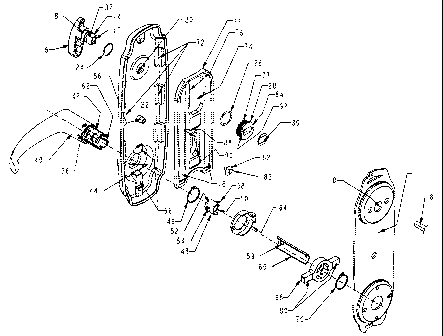Some of the information on this Web page has been provided by external sources. The Government of Canada is not responsible for the accuracy, reliability or currency of the information supplied by external sources. Users wishing to rely upon this information should consult directly with the source of the information. Content provided by external sources is not subject to official languages, privacy and accessibility requirements.
Any discrepancies in the text and image of the Claims and Abstract are due to differing posting times. Text of the Claims and Abstract are posted:
| (12) Patent: | (11) CA 2163292 |
|---|---|
| (54) English Title: | INTERCONNECTED LOCK |
| (54) French Title: | SERRURE COMPOSEE |
| Status: | Expired and beyond the Period of Reversal |
| (51) International Patent Classification (IPC): |
|
|---|---|
| (72) Inventors : |
|
| (73) Owners : |
|
| (71) Applicants : |
|
| (74) Agent: | NORTON ROSE FULBRIGHT CANADA LLP/S.E.N.C.R.L., S.R.L. |
| (74) Associate agent: | |
| (45) Issued: | 2004-11-09 |
| (22) Filed Date: | 1995-11-20 |
| (41) Open to Public Inspection: | 1996-06-21 |
| Examination requested: | 2002-11-13 |
| Availability of licence: | N/A |
| Dedicated to the Public: | N/A |
| (25) Language of filing: | English |
| Patent Cooperation Treaty (PCT): | No |
|---|
| (30) Application Priority Data: | ||||||
|---|---|---|---|---|---|---|
|
An interconnected lockset comprising an upper
deadbolt assembly including a rotatable spindle, a
turn piece secured to the spindle, the turn piece
rotatable from either of two symmetrical unlocked
orientations to a locked orientation, and a pinion
secured to the turn piece, a lower lever assembly
including a rotatable element, an operator secured to
the rotatable element, and a cam having opposed arms
secured for displacement with the operator, and a
rose for supporting the turn piece and the operator,
a vertically displaceable rack including a pair of
adjacent legs for engagement with the opposed arms,
a vertically extending row of rack teeth, the row of
teeth rack being selectively located so that the
teeth can be either located on one side of the pinion
to rotate the turn piece clockwise from one of the
unlocked orientations to the neutral locked
orientation or located on the other side of the
pinion to rotate the turn piece counterclockwise from
the other unlocked orientation to the neutral locked
orientation.
Note: Claims are shown in the official language in which they were submitted.
Note: Descriptions are shown in the official language in which they were submitted.

2024-08-01:As part of the Next Generation Patents (NGP) transition, the Canadian Patents Database (CPD) now contains a more detailed Event History, which replicates the Event Log of our new back-office solution.
Please note that "Inactive:" events refers to events no longer in use in our new back-office solution.
For a clearer understanding of the status of the application/patent presented on this page, the site Disclaimer , as well as the definitions for Patent , Event History , Maintenance Fee and Payment History should be consulted.
| Description | Date |
|---|---|
| Time Limit for Reversal Expired | 2010-11-22 |
| Letter Sent | 2009-11-20 |
| Inactive: IPC from MCD | 2006-03-12 |
| Inactive: IPC from MCD | 2006-03-12 |
| Grant by Issuance | 2004-11-09 |
| Inactive: Cover page published | 2004-11-08 |
| Pre-grant | 2004-08-18 |
| Inactive: Final fee received | 2004-08-18 |
| Notice of Allowance is Issued | 2004-07-20 |
| Notice of Allowance is Issued | 2004-07-20 |
| Letter Sent | 2004-07-20 |
| Inactive: Approved for allowance (AFA) | 2004-07-12 |
| Letter Sent | 2003-12-10 |
| Letter Sent | 2003-12-10 |
| Inactive: Multiple transfers | 2003-09-18 |
| Letter Sent | 2002-12-06 |
| Inactive: Status info is complete as of Log entry date | 2002-12-06 |
| Inactive: Application prosecuted on TS as of Log entry date | 2002-12-06 |
| Amendment Received - Voluntary Amendment | 2002-11-13 |
| Request for Examination Requirements Determined Compliant | 2002-11-13 |
| All Requirements for Examination Determined Compliant | 2002-11-13 |
| Application Published (Open to Public Inspection) | 1996-06-21 |
There is no abandonment history.
The last payment was received on 2003-11-04
Note : If the full payment has not been received on or before the date indicated, a further fee may be required which may be one of the following
Please refer to the CIPO Patent Fees web page to see all current fee amounts.
| Fee Type | Anniversary Year | Due Date | Paid Date |
|---|---|---|---|
| MF (application, 2nd anniv.) - standard | 02 | 1997-11-20 | 1997-10-29 |
| MF (application, 3rd anniv.) - standard | 03 | 1998-11-20 | 1998-11-02 |
| MF (application, 4th anniv.) - standard | 04 | 1999-11-22 | 1999-11-04 |
| MF (application, 5th anniv.) - standard | 05 | 2000-11-20 | 2000-11-03 |
| MF (application, 6th anniv.) - standard | 06 | 2001-11-20 | 2001-11-13 |
| MF (application, 7th anniv.) - standard | 07 | 2002-11-20 | 2002-10-30 |
| Request for examination - standard | 2002-11-13 | ||
| MF (application, 8th anniv.) - standard | 08 | 2003-11-20 | 2003-11-04 |
| Final fee - standard | 2004-08-18 | ||
| MF (patent, 9th anniv.) - standard | 2004-11-22 | 2004-11-03 | |
| MF (patent, 10th anniv.) - standard | 2005-11-21 | 2005-11-02 | |
| MF (patent, 11th anniv.) - standard | 2006-11-20 | 2006-10-30 | |
| MF (patent, 12th anniv.) - standard | 2007-11-20 | 2007-10-30 | |
| MF (patent, 13th anniv.) - standard | 2008-11-20 | 2008-10-30 |
Note: Records showing the ownership history in alphabetical order.
| Current Owners on Record |
|---|
| EMHART INC. |
| NEWFREY LLC |
| Past Owners on Record |
|---|
| MARTIN ZUCKERMAN |